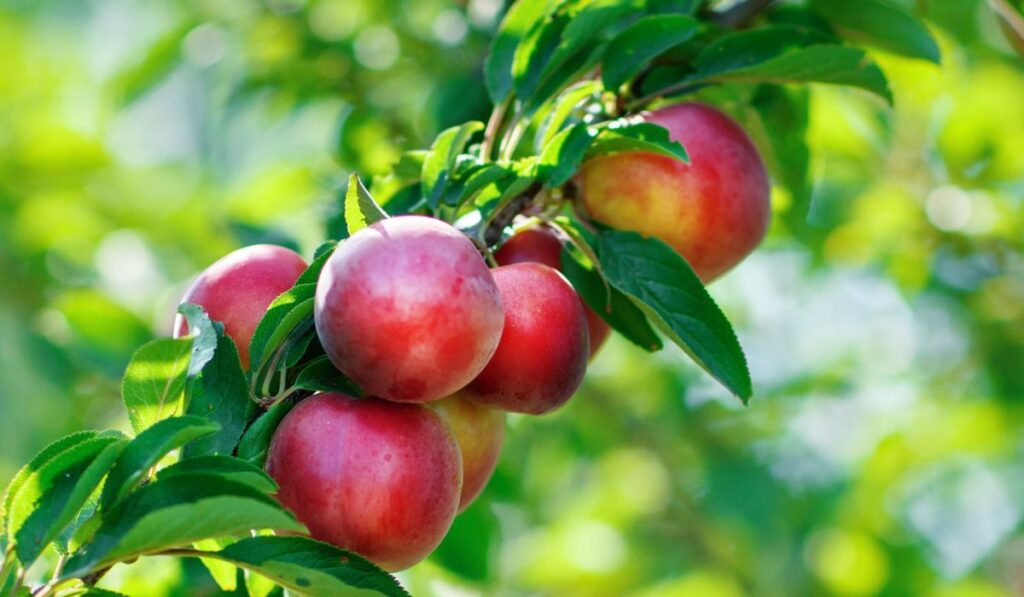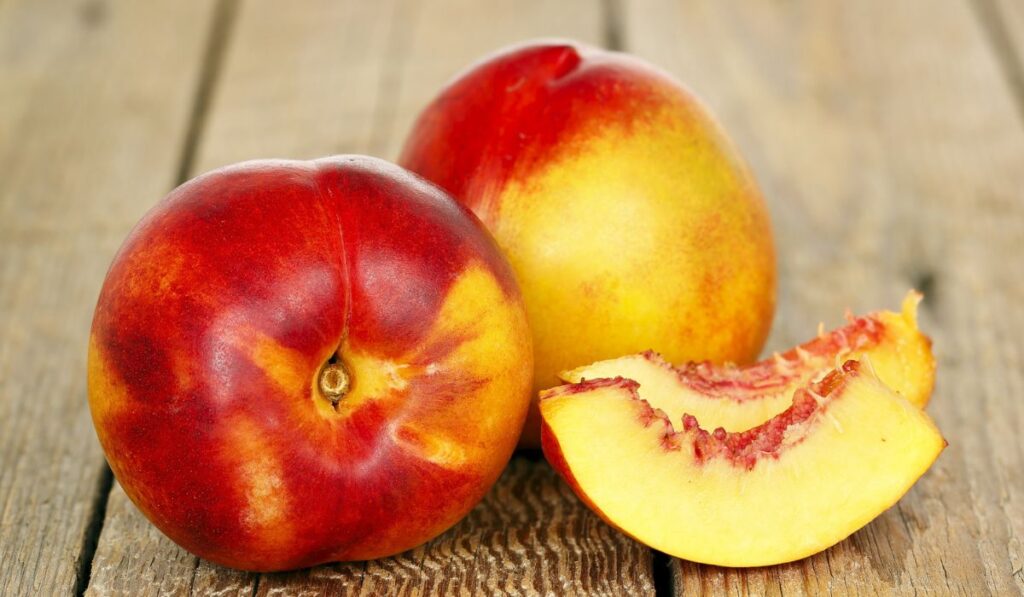Nectarines are a popular Summer treat that can be enjoyed fresh, cooked, or in various recipes. Many people have fond memories of nectarines and their sweet yet slightly tart flavor. But which months are nectarines in season, and how do you know if you’re selecting the right fruit?
Nectarines are in season from late April to August. However, the peak season is in June, July, and August depending on the type. Nectarines aren’t ripe if they have any green hues around the stem. Ripe nectarines have a slightly firm texture and a sweet aroma.
Nectarines are an amazingly sweet and nutrient-dense fruit you can add to your diet during the Summer months. But you might be wondering if nectarines are the same as peaches and what health benefits they offer. Here’s everything you need to know and more.
What are Nectarines?

Nectarines are a sweet Summer fruit belonging to the rose family. Nectarines are also known as stone fruits due to their large hard pits. Many people confuse nectarines with peaches.
Although they are similar, nectarines and peaches are two different fruits with different genetics and tastes. Nectarines are different from peaches due to a genetic mutation that gives them smooth skin as opposed to a peach’s fuzzy exterior. As a result, nectarines are typically smaller, sweeter, and more aromatic.
It’s believed that nectarines started in China between 2,000 and 4,000 B.C. and were grown in ancient Greece, Rome, and Persia.
Are Nectarines a Summer Fruit?
Nectarines are one of the best Summer fruits. Generally speaking, nectarines are in season from late April to August. Depending on the type, the peak season for nectarines is in June, July, and August. However, Chilean nectarines are in season from December to March.
You can find the freshest nectarines at your local farmer’s market during the Summer months. Or you can easily spot them at your favorite supermarket from late April to the end of August.
You can also get sun-dried Nectarines (example on Amazon) in the off seasons!
Are Nectarines Good for You?
You might think that nectarines aren’t as healthy as other fruits due to their delightful flavor. But this fruit is chock full of nutrients, minerals, and health benefits.
One medium-sized nectarine is around 65 calories, making it a reasonably light snack. Here are some other health benefits of this summer fruit.
High in Antioxidants
Nectarines contain large amounts of antioxidants. Antioxidants can help decrease oxidative stress caused by free radicals in your body. Oxidative stress can cause health complications like diabetes, Alzheimer’s, and heart disease.
Nectarines also contain antioxidants known as flavonoids and anthocyanins. These compounds add to the appearance, taste, and aroma of nectarines and other fruits.
In addition, flavonoids may reduce the risk of age-related decline in cognitive function, while anthocyanins can help reduce inflammation and heart disease.
May Decrease the Risk of Cancer
Nectarines contain phenolic compounds, and studies suggest that these compounds may decrease cancer risk.
For example, one study, including over 470,000 adults, found significant links between diets higher in fruits, including nectarines, and a reduced chance of lung cancer in men. The study believes these benefits come from the antioxidants in these fruits.
Just remember that more research needs to be conducted before we can find a definitive answer. However, adding nectarines and other fruits to your diet will positively affect your health.
May Improve Skin Health
Nectarines contain high amounts of copper, which may help skin health. In fact, one medium nectarine contains over 10% of the recommended daily intake.
Copper increases the growth of cells in the dermis layer. Copper also helps protect your skin from damage, helps aging skin, and promotes collagen development.
Nectarines offer Vitamin B3 and Vitamin A as well. Vitamin B3 may help protect skin cells from damage caused by the sun, and Vitamin A is an essential nutrient for healthy skin.
May Help Weight Loss
It’s no surprise that adding fruits to your diet can aid weight loss. However, nectarines may be a fruit to consider more highly. Nectarines offer a good source of fiber which can help you feel full for longer.
Nectarines are also low in calories and fat. In fact, one medium-sized nectarine is under 100 calories. In addition, low-calorie fruits and vegetables can help support weight loss enjoyed in place of calorie-dense snacks low in nutrients.
How do You Know When Nectarines are Ready to Eat?
You’ll need to know how to spot the perfect nectarine to enjoy this fruit to the fullest. Unlike other fruits, the skin color of a nectarine doesn’t indicate its ripeness. Well, not entirely. The nectarine isn’t fully ripe and needs a few more days if you notice green tints around the stem.
When pressed, nectarines also have a slightly firm texture with a slight give. You might also notice tiny white speckles known as sugar spots. These markings can indicate higher levels of sweetness. Avoid fruits with bruises or dark markings and instead, look for nectarines with an orange-ish gold hue.
Finally, the smell is the best way to tell if a nectarine is ready to eat or of high quality. Generally speaking, the more aromatic a fruit is, the better the flavor.
Should You Refrigerate Nectarines?
Be sure never to refrigerate a nectarine until it’s fully ripe. When left at room temperature, nectarines and peaches will continue to ripen even after being harvested—placing these fruits in the fridge before they are ripe results in a mealy texture and flavorless fruit.
If they aren’t fully ripe, it’s okay to store nectarines on your kitchen counter or in a paper bag for one to two days.
How do You Prepare a Nectarine?

One of the best ways to enjoy a nectarine is to eat it fresh. If the nectarine is ripe and high-quality, it will taste sweet, juicy, and delicious.
If you plan on cooking a nectarine, it doesn’t need to be peeled beforehand, unlike a peach. And you can enjoy nectarines in various ways by grilling them, adding them to salads, or using them in desserts.
Grilled nectarines are a popular Summer treat and can be used in entrees or side dishes. You can also add nectarines to your morning yogurt with other fruits, granola, or toppings.
Nectarines are popular additions to desserts, jams, and sauces as well. You can make pies or cakes or top them over ice cream. But regardless of how you choose to prepare nectarines, you’re sure to enjoy the sweet and juicy flavor.
